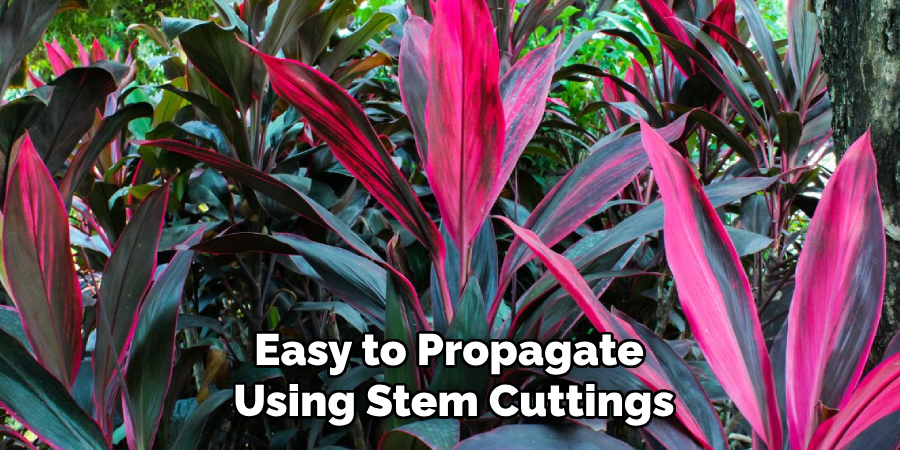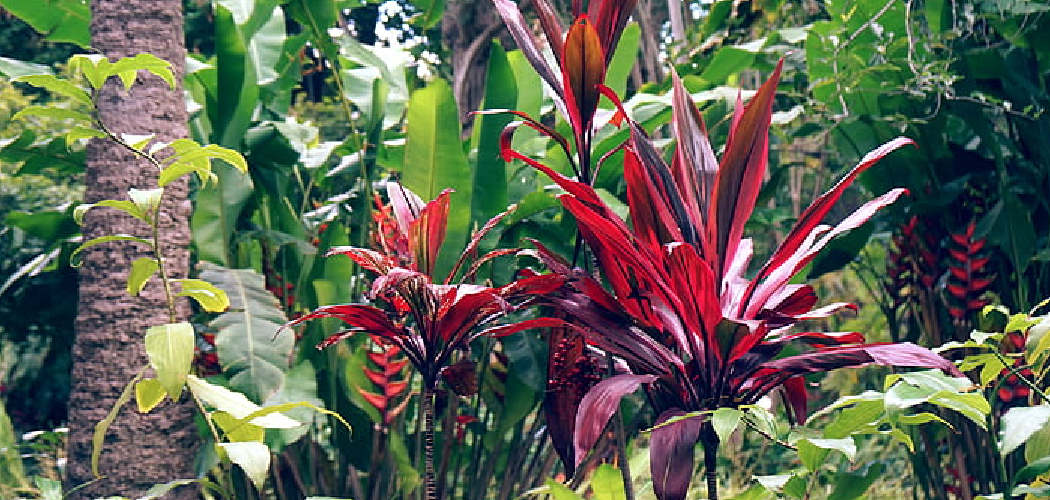Ti plants, with their striking, colorful foliage, are a favorite among gardeners and houseplant enthusiasts. These plants, also known as Cordyline fruticosa, are cherished for their vibrant leaves that come in shades of green, red, pink, and even purple, making them a popular choice for both indoor and outdoor decoration.

Whether you’re looking to liven up your living space or add a tropical touch to your garden, learning how to grow ti plants can help you achieve lasting beauty and thrive. This guide will cover all the essentials, from choosing the right location to long-term care, ensuring that your ti plants remain healthy and vibrant.
Understanding Ti Plants
What Are Ti Plants?
Ti plants are evergreen shrubs native to Southeast Asia and the Pacific Islands. Often associated with luck and protection in Hawaiian culture, these plants are widely recognized for their distinct, sword-like leaves and vivid colors. They can grow up to 10 feet tall in outdoor settings and make excellent container plants for those who prefer to keep them indoors.
Benefits of Growing Ti Plants
One of the main reasons ti plants are so popular is their versatility. They can thrive both indoors and outdoors, providing gardeners with flexibility in where they grow them. Additionally, these plants are relatively low-maintenance, making them ideal for beginners. Their bold, vibrant colors add a decorative flair to any space, and when placed outdoors, they can create an exotic, tropical atmosphere.
Choosing the Right Location for Ti Plants
Ideal Climate
Ti plants thrive in warm, humid climates and are best suited for USDA hardiness zones 9-12. If you live in a cooler region, you can still grow these plants indoors or in containers that can be moved indoors during colder months.

Light Requirements
For outdoor planting, choose a location with partial shade to filtered sunlight. While ti plants can tolerate full sun, too much direct sunlight can scorch their leaves. Indoors, place the plant near a bright window with indirect light to help it flourish.
How to Grow Ti Plants: Planting Process
Preparing the Soil
Ti plants prefer well-draining, fertile soil with a slightly acidic to neutral pH level between 6.0 and 6.5. Before planting, amend the soil with organic matter or compost to improve its drainage and nutrient content. Avoid using heavy, clay-like soils as these can suffocate the plant’s roots.
Propagation
Ti plants can be propagated through stem cuttings or by division. When taking a cutting, make sure it is at least 4 to 6 inches long and contains one or two nodes (where leaves emerge). Remove any lower leaves and dip the cut end into rooting hormone before planting in moist potting soil. Keep the cutting in a warm, humid environment until it develops roots.
To divide a mature Ti plant, gently remove it from its pot and carefully separate the root ball into multiple sections, ensuring each section has enough roots and leaves to survive on its own. Replant the divisions in fresh potting soil and water thoroughly.
Pests and Diseases
Ti plants are generally hardy and resistant to pests and diseases. However, they can sometimes be susceptible to mealybugs, spider mites, and aphids. To prevent these pests from infesting your plant, regularly inspect it for any signs of insects and treat with insecticidal soap or neem oil if necessary.
Over-watering can also lead to root rot in Ti plants. Make sure to allow the top layer of soil to dry out before watering again. If you notice any wilting or yellowing leaves, it may be a sign of over-watering, and you should adjust your watering routine accordingly.

Watering and Fertilizing Ti Plants
How Much Water Do Ti Plants Need?
Ti plants like consistent moisture but should not be overwatered. Water the plant when the top inch of soil feels dry to the touch. During warmer months, increase the frequency to keep the soil consistently moist. Be sure to reduce watering in winter when the plant’s growth slows down.
Fertilizing Tips
Use a balanced, water-soluble fertilizer every 4-6 weeks during the growing season to provide the nutrients to plants need for vibrant foliage. Avoid over-fertilizing, as this can lead to salt buildup in the soil, which may damage the roots.
Pruning and Maintenance
Pruning Techniques
Pruning is essential to keep ti plants looking their best. Remove any yellowing or damaged leaves regularly to maintain the plant’s appearance. If the plant becomes too tall or leggy, cut the stem back to encourage new growth from the base.
General Maintenance
Wipe down the leaves occasionally to remove dust and improve photosynthesis. Ensure the plant is not exposed to heavy drafts or sudden temperature changes, which can stress it and cause leaf drop.
Common Pests and Problems
Pests to Watch Out For
Ti plants can attract pests like spider mites, mealybugs, and scale. Check the undersides of leaves regularly for signs of infestation, such as webbing or sticky residue. Treat pests with insecticidal soap or neem oil as needed.
Troubleshooting Growth Issues
If your plant’s leaves start browning or curling, it could be due to inconsistent watering or exposure to cold drafts. Adjust your care routine and monitor the plant closely for improvements.
Propagating Ti Plants
Stem Cuttings Method
Ti plants are easy to propagate using stem cuttings. Cut a healthy stem into segments with at least one node each. Place the cuttings in water or soil, ensuring the node is buried. Keep the cutting in a warm, humid environment, and roots should develop within a few weeks.

Benefits of Propagation
Propagating ti plants not only saves money but also allows you to expand your collection or share your vibrant plants with friends and family. It also helps to rejuvenate older plants that may have become leggy or overgrown.
Tips for Successful Propagation
- Choose healthy stems with at least one node.
- Use a clean, sharp tool to make the cuts.
- Place cuttings in a warm and humid environment, such as a greenhouse or under a plastic bag.
- Keep soil moist but not waterlogged to prevent rotting of the cuttings.
- Transplant rooted cuttings into individual pots once they have established roots.
Other Methods of Propagation
Apart from stem cuttings, ti plants can also be propagated through division or air layering. Division involves separating the plant into smaller sections with their own root systems, while air layering involves creating roots on a branch still attached to the parent plant.
Indoor vs. Outdoor Ti Plants
Growing Indoors
When growing ti plants indoors, ensure they are placed in a bright location with indirect sunlight. Use a humidifier or mist the plant regularly to mimic its natural humid environment.
Growing Outdoors
Outdoor ti plants should be planted in locations that provide partial shade and protection from strong winds. Mulch around the base to retain soil moisture and regulate temperature.
Seasonal Care Tips
Summer Care
During the warmer months, check the soil moisture regularly and fertilize as needed to support growth. Place outdoor ti plants in a location where they receive protection from harsh midday sun.
Winter Care
For outdoor plants in colder climates, move them indoors or cover them with frost cloths during frosty nights. Reduce watering and avoid fertilizing during the winter dormant period. Indoor plants should be placed in a location with bright, indirect light and kept away from drafts. Increase humidity levels by misting the leaves or placing a tray of water and pebbles under the plant.

Frequently Asked Questions
How Often Should I Water My Ti Plant?
Ti plants prefer consistently moist soil but do not like to sit in water. Water when the top inch of soil feels dry to the touch, ensuring proper drainage to prevent root rot.
Can Ti Plants Tolerate Low Light Conditions?
While ti plants thrive in bright, indirect light, they can tolerate lower light conditions. However, their vibrant leaf colors may fade if exposed to insufficient sunlight.
What Type Of Soil Is Best For Ti Plants?
Ti plants grow best in well-draining, fertile soil with a slightly acidic pH. Incorporating organic matter or compost can enhance soil quality and support healthy growth.
How Do I Propagate A Ti Plant?
Propagating a ti plant is simple. You can use stem cuttings placed in water until roots form or plant them directly into soil. Ensure the cuttings come from healthy parent plants for best results.
Why Are My Ti Plant’s Leaves Turning Yellow?
Yellowing leaves can occur due to overwatering, underwatering, or lack of nutrients. Evaluate your watering routine and consider supplementing with a balanced fertilizer to maintain plant health.
Conclusion
Ti plants are a stunning addition to any indoor or outdoor space, offering vibrant colors and low-maintenance care. By following the steps outlined in this guide, you’ll know exactly how to grow ti plants and ensure they thrive year-round.
With proper watering, fertilizing, pruning, and protection from pests, your ti plants will reward you with beauty and lush growth for years to come. Whether you’re an experienced gardener or just starting, ti plants are a wonderful choice to brighten up any space.

